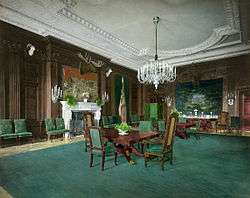Herter Brothers

The firm of Herter Brothers, New York, (working 1864–1906), founded by Gustave (1830–1898) and Christian Herter (1839–1883), begun as an upholstery warehouse, became one of the first firms of furniture makers and interior decorators in the United States after the Civil War. With their own design office and cabinet-making and upholstery workshops, Herter Brothers were prepared to accomplish every aspect of interior furnishing including decorative paneling and mantels, wall and ceiling decoration, patterned floors and carpets and draperies.
History

Cabinet, 1875, ebonized cherry, veneer inlays, and metallic foil decorative paper.
Beginnings
The Herters were born in Stuttgart, Württemberg. Gustave was born Julius Gustav Alexander Hagenlocher, with his unmarried mother's surname. She married Christian Herter (1807–1874) in 1835, and he adopted Gustave. Christian Augustus Ludwig Herter, Gustave's half-brother, was born in 1839. Gustave and Christian's father was a skilled cabinetmaker and they followed him in the trade. Gustave Herter came to New York City in 1848 and by 1858 was working under his own name. Christian was in New York by 1859 and joined his brother in the firm (renamed Herter Brothers) by 1864.[1]
The firm was at the forefront of the panoply of furnishing styles that preceded the Mission style: Renaissance Revival, Neo-Grec, Eastlake, the Aesthetic Movement, ebonized "Anglo-Japanese style" furnishings of the 1870s – 1880s for which the firm is best recognized today, and the wide range of furnishings in revival styles required for Gilded Age houses.
Prominent clients
The Red Room of the White House was furnished with Herter Brothers furniture during the administration of Ulysses S. Grant. Several pieces of Herter Brothers furniture remain in the White House including a center table and a slipper chair. This center table bears the remains of the only known Herter Brothers paper label; generally the firm stamped their furniture, a common practice in the 19th Century.
Among their most prominent clients were the Vanderbilts. Between 1879 and 1882, Herter Brothers decorated William Henry Vanderbilt's new Fifth Avenue mansion.
At 634 Fifth Avenue, in 1880–1882, they decorated the mansion of Darius Ogden Mills, on the site of part of Rockefeller Center now occupied by the colossal bronze Atlas. Their bills came to US$450,000.[2] At the same time they were furnishing the nearby Jay Gould residence at 579 Fifth Avenue, at Forty-seventh Street.
The Herters did much of the interior work for the Eldridge Street Synagogue.
The White House's interiors were extensively renovated during the administration of Theodore Roosevelt. Executing the designs of architect Charles Follen McKim, Herter Brothers created the plaster ceiling and ornately-carved oak paneling for the expanded State Dining Room. The firm's workshops also provided the heavily carved paneling for the renovated East Room.
Interiors and furniture
Very few Herter Brothers interiors remain extant. "Elm Park" in Norwalk, Connecticut was built 1864-68, and partially decorated by Herter Brothers. Open to the public as the Lockwood-Mathews Mansion Museum, the drawing room, music room and rotunda/art gallery are examples of the Herters' interior design schemes, including lavishly carved and inlaid woodwork and frescoed walls and ceilings. The recently restored drawing room retains a suite of Herter furniture purchased for it by the home's second owner, Charles D. Mathews.
Furniture from an early Herter commission survives in Victoria Mansion in Portland, Maine.[3]
A notable surviving Herter interior is the John Thatcher home, now the Rosemount Museum, in Pueblo, Colorado (however, this work was carried out by the firm after the death of Christian Herter and the retirement of his brother, Gustave; connoisseurs and collectors tend to concentrate on the furniture and interiors designed during the brothers' supervision of the firm).
Examples of Herter furniture are in major public collections in the United States. The Metropolitan Museum of Art in New York City presented an exhibition, "Herter Brothers: Furniture and Interiors for a Gilded Age," in 1995.
-
Bookcase (1852-53), Nelson-Atkins Museum of Art, Kansas City,
-

Chairs, left (1867-69), center (1869-70), right (1883-84), Metropolitan Museum of Art.
-

Mirror (1872-73), Los Angeles County Museum of Art.
-
Firescreen (c. 1878-80), Cleveland Museum of Art.
-

Chest-of-Drawers, ca. 1880. Brooklyn Museum
-

Bedstead (1880), ebonized cherry, veneer inlays, High Museum of Art, Atlanta, Georgia.
-

Cabinet (c. 1880), Museum of Fine Arts, Boston.
-

The State Dining Room, following the 1902 renovations.
References
- ↑ Howe, K. S., Gustave and Christian Herter: the European connection, Magazine Antiques, September 1, 1994
- ↑ Harwood, B.R., A Herter Brothers library rediscovered, Magazine Antiques, May, 2002
- ↑ "Victoria Mansion". Victoria Society of Maine. September 29, 2007.
- Howe, Katherine S. Herter Brothers: Furniture and Interiors for a Gilded Age. Harry N. Abrams: Metropolitan Museum of Art in association with the Museum of Fine Arts, Houston, 1994. ISBN 0-8109-3426-4.
- Lambourne, Lionel. The Aesthetic Movement. Phaidon Press: 1996. ISBN 0-7148-3000-3.
External links
- Barry R. Harwood, "A Herter Brothers library rediscovered" from The Magazine Antiques, May, 2002
- Metropolitan Museum: Library Table for William Henry Vanderbilt
- Michael S. Schneider, "Geometry of a Herter Brothers Cabinet" Geometric analysis of a cabinet, ca,1883
- Herter Brothers Pictorial Histories
- Winterthur Library Overview of an archival collection on Herter Brothers.
| Wikimedia Commons has media related to Herter Brothers. |